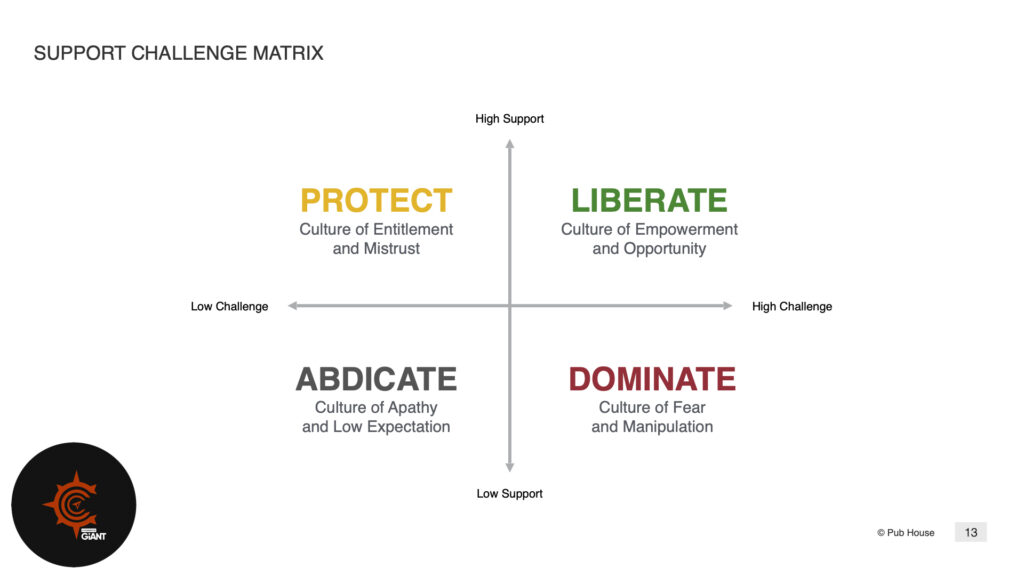Most of us, if any, do not possess the innate ability to organically create a culture of empowerment and opportunity for those we lead. To define the behaviors that foster such a culture, we use a matrix based on two variables: high support and high challenge. By effectively calibrating these variables in the various spheres of influence in our lives, we can inspire and motivate people to thrive. We provide them with opportunities and empower them to believe in their own capabilities, even when they are unsure of themselves.
However, it is crucial to strike a balance between high challenge and high support. When a culture becomes excessively focused on challenge but fails to provide sufficient support, over time, the culture tends to foster a dominator tendency. This kind of culture is characterized by fear and manipulation (among other things), as individuals feel uncertain about their standing. They become more motivated by the worry of failing the expectations of their superiors rather than the desire to perform with excellence. In such cases, hidden criticism and judgement often festers, which undermine and hampers the growth of all involved.
Each of us tends to lean toward support or challenge along a spectrum.
Personally, I have discovered that my default tendency—particularly under pressure—is to lean more heavily into challenge rather than support. I’ve had to intentionally cultivate an awareness of this tendency as well as to actively work to establish better and more effective ways for leaning in to provide more support to others in order to balance the default tendency heavily weighted to challenge.
Conversely, some individuals naturally excel in building relationships, showing compassion, and providing support. However, they may struggle with effectively bringing challenge. In a culture where leaders prioritize support but struggle with bringing appropriate challenge, a protector tendency emerges. This type of leader inadvertently creates a sense of entitlement and mistrust in those he or she leads. Over time, team members come to expect that they will not be challenged or pushed to grow.
Leaders who find themselves in the protect quadrant tend to express their dissatisfaction through passive aggression rather than straightforwardness as their frustration slowly builds. Consequently, when an undesired behavior is multiplied over the course of time by a team member, the leader in the protect quadrant often reacts explosively, leaving the person on the receiving end confused and feeling the response is disproportionate. They may wonder why the issue was not addressed earlier, providing them with an opportunity to improve. This creates an unpredictable atmosphere where individuals feel they are walking on egg shells, second guessing their actions and unsure when they will face another outbursts from their leader.
Finally, there are people in leadership positions who neither provide support nor challenge (even though they once may have), resulting in an abdicator tendency. These leaders in the abdicate quadrant have adopted an indifferent attitude, essentially telling their team members to carry on without much interest or investment. Often times this is a leader who is experiencing some kind of significant pain or disappointment in some important area in their life. The leader is not well and likely needs some help. Otherwise a culture of apathy and low expectations will ensue and the company or organization will suffer. Individuals in this culture will feel that their efforts go unnoticed and that no one is willing to invest in their growth.
Ultimately, the mature leader provides the right mix of high support and high challenge. This person leads with strength as well as tenderness. People on this person’s team feel inspired, cared for and called up. They feel seen and valued and like they are truly part—an important part—of a team.
This matrix is an essential tool for leaders who genuinely desire to influence and impact the lives of those they lead. Learning how to effectively balance and calibrate support and challenge is crucial. It requires growth and development for all of us, as none of us naturally excel in both areas. Protectors need to learn how to deliver effective challenge, enabling people to fulfill their full potential. On the other hand, those inclined toward domination need to focus on providing support, building relationships, coaching, equipping, and empowering others. Those who are abdicating may need something else altogether.
By demonstrating a genuine commitment to the growth and well-being of individuals, leaders can create a transformative environment where people realize that their leader is genuinely invested in their success and the team that forms in this environment becomes extremely effective.

